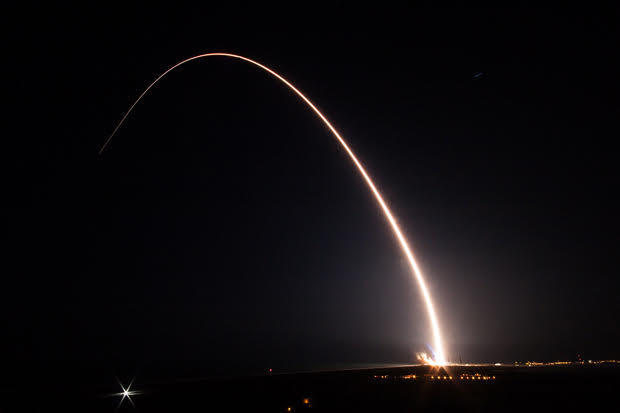Delta 4 rocket launches powerful military satellite
A United Launch Alliance Delta 4 rocket boosted a $424 million military communications satellite into orbit Saturday evening, the latest in a globe-spanning constellation of high-speed relay stations used by the United States and a half-dozen partner nations.
The Boeing-built Wideband Global SATCOM -- WGS-9 -- communications station will provide high-speed communications services to U.S. and allied nations, including drone command and control, voice and video links, messaging, data relay, email and television broadcasts to troops in the field.
The satellites are used by The White House, the State Department and all branches of the U.S. military. Australia, Canada, Denmark, the Netherlands, Luxembourg and New Zealand paid for two of the satellites in the fleet and are able to use a portion of the network in return.
“WGS provides anytime, anywhere communications for soldiers, sailors, airmen, marines and international partners through broadcast, multicast and point-to-point connections,” said Robert Tarleton, director of the Air Force’s Military Satellite Communications Systems at the Space and Missile Systems Center.
“This very successful cooperative effort, along with the U.S. and Australia cooperative effort for WGS-6, enhances the foundation for long-term cooperation in military satellite communications and has been very effective in promoting increased interoperability among our strategic allies.”
Putting on a spectacular weekend sky show, the Delta 4’s hydrogen-fueled main engine and four strap-on solid-fuel boosters ignited on time at 7:44 p.m. ET, generating 1.8 million pounds of thrust and instantly pushing the booster away from launch complex 37 at the Cape Canaveral Air Force Station.
Generating a brilliant plume of fiery exhaust visible for miles around, the 217-foot-tall rocket smoothly climbed away, consuming propellants at a furious rate, shedding weight and quickly accelerating.
The four strap-on boosters burned out in pairs and were kicked away from the first stage about one minute and 42 seconds after liftoff. The Aerojet Rocketdyne RS-68A first stage engine shut down as planned just under four minutes into flight.
The spent stage then fell away and the second stage RL10B-2 engine, also built by Aerojet Rocketdyne, ignited and fired for another 15-and-a-half minutes to put the vehicle and its satellite payload into a preliminary elliptical orbit.
A second three-minute burn finished the job and about 42 minutes after liftoff, the 13,000-pound Wideband Global Satcom 9 satellite was released into a so-called “super-synchronous” transfer orbit with a low point of around 270 miles and a predicted high point of about 27,571 miles.
Over the next several weeks, small on-board thrusters will be used to circularize the orbit at an operational altitude 22,300 miles above the equator. At that altitude, satellites take 24 hours to complete one orbit and appear to hang stationary in the sky, allowing the use of fixed antennas on the ground along with line-of-sight communications with mobile forces.
After WGS-9 reaches its final orbit, Boeing engineers will spend several weeks checking out and testing the relay station and maneuvering it to a classified position before turning it over to the Pentagon. WGS-9 and WGS-8, launched last December, are both expected to be operational later this year.
One more WGS satellite will be launched late next year, the tenth member of a constellation replacing older Defense Satellite Communication System spacecraft.
Each WGS spacecraft has 10 times the capability of the older satellites and, starting with WGS-7, an additional 17 percent improvement in bandwidth due to operational changes. WGS 8 and 9 feature 90 percent more bandwidth than earlier models using a high-tech router-like device known as a Wideband Digital Channelizer provided by IBM.
The solar-powered satellite features eight steerable X-band beams and 10 Ka-band beams covering 19 independent coverage areas, along with full-Earth coverage in X-band.
This was the 35th launch of a Delta 4 rocket since the current version of the booster began flying in 2002, all of them successful. Including less powerful Delta 2 boosters and Atlas 5 rockets, ULA has now flown 118 successful missions in a row. ULA, a partnership between Boeing and Lockheed Martin, was formed in December 2006.





